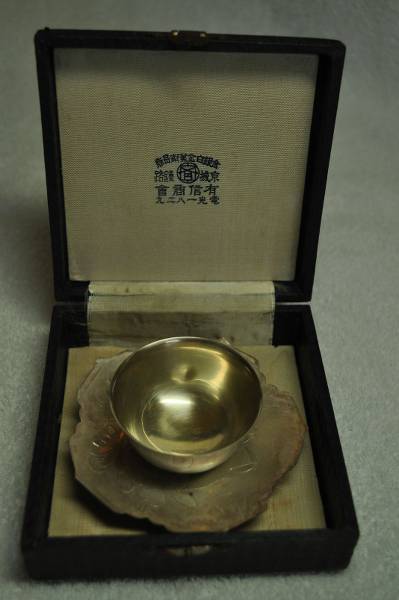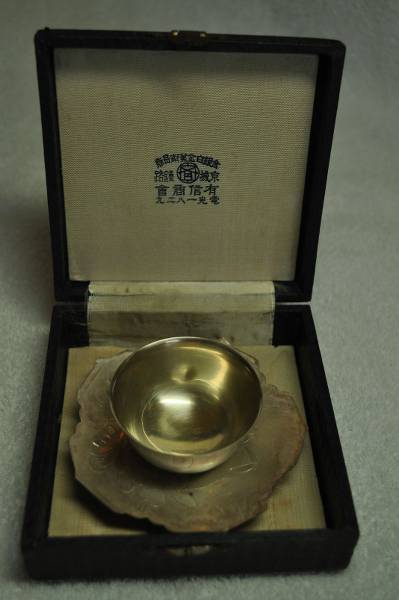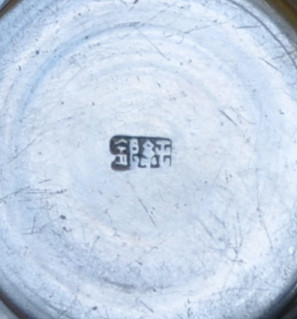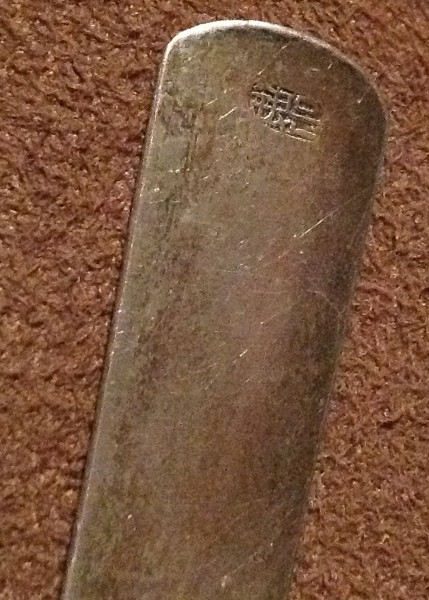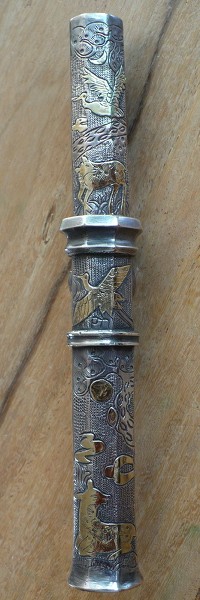

This silver dagger was bought in Korea in 1978. At that time I visited Korea together with my father as he went on a so called Korean War Veteran visit. We toured Korea and on our way to the Korean demilitarized zone, I noticed the dagger in a small medicine/herbal shop. I was struck by its beauty and didn't know anything about the dagger but bought it. 25 Years later I started to investigate and discovered its name and the history behind it. Information is obtained by an appraisal done by Martin Barnes Lorber, other by means of private mailings or is picked off the internet.
My gratitude goes towards; Yenhau Chen & Walter Del Pellgrino and V&A Museum and Rob & Kyoko Turley (Korean Art and Antiques).
This is a Korean blade. It goes by many names including Jangdo and Eunjando (for silver examples). It is considered a ceremonial knife rather than a military or fighting knife.
Size may help determine its age. Larger knives were more prevalent before the 19th century and were carried by both noblemen and noblewomen. Very small ones became popular in the 19th and 20th century as a bride's accessory in the wedding ceremony.
Jangdo is a short knife carried easily. It was used for protection or for decoration. Of the various kinds of Jangdo, the one carried on the body is called Paedo, the one kept in the pocket is called Nangdo. In addition to them, there are many kinds by shape and by material. By knife case shape, there are Samojangdo in a square case and Mojaebijangdo in an octagonal case. As well, by material, there are Gold Jangdo, Silver Jangdo, and White Gem Jangdo. During the late Joseon period, knife making became more sophisticated and complicated as Jangdo was regarded as a luxury pendant accessory. Jangdo made in Gwangyang, Jeollanam-do is famous for its long history and sophistication.
The name “Jangdo” appeared during the early Joseon, Chosŏn, Choseon or Chosun (朝鮮, 조 ) (1392 -1905) period. During the Joseon dynasty the “Sadeabu” or Gentry class always carried the Eunjangdo.
Some highlights from “Korean Thoughts and Religion”; Joseon women lived in constant fear of being rejected by their husbands and their families. Husbands had many reasons to legally reject their wives, i.e., the "seven deadly sins of wives" or chilgeojiak: disobedience to the parents in law; failure to produce a son; adultery; theft; undue jealousy; grave illness; and extreme talkativeness. Similar provisions for wives did not exist, and the threat of being rejected by their husbands was real enough for them to live in constant fear and to be always obedient and submissive toward their husbands.
The husband's ill-treatment of his wife and in-laws was also common. In addition, chastity was imposed upon women, including widows, while men freely engaged in extramarital affairs, especially if their wives could not bear children or failed to give birth to a son.
Chastity was particularly demanded of noble women, who were allowed to step out of the house only with their face and body fully covered. In the unlikely event of a stranger seeing the woman's face or touching her, she was expected to punish herself physically. Noble women also had to carry the Eunjangdo, a small knife always ready to be used for self-mutilation in the event of sexual assault.
What was most unfair of all was both the ideology and the law that stressed the indissolubility of marriage for women but not for men. When the husband died, the wife and son had to observe a mourning period of three years. In addition, the virtuous widow was to remain faithful to her husband's family till death, especially if she had already become the mother of that patrilineage's male descendent. Widows, even when their husbands died young, were pressured to remain faithful by not remarrying and obediently serving their husbands parents.
By stressing the woman's dedication to one husband and one lineage as the greatest womanly virtues, Confucian ideology eliminated the rationale for remarrying. "A woman must follow by one man" became a sacred norm, dictating that even a widow, no matter how young, should always remain faithful to her dead husband and his family. In order to completely subordinate women to the man's family, Joseon rulers indoctrinated women into believing that inhibition against remarriage was a sort of divine providence. For more information see:
http://www.hcrg.org/iii/printview.asp?num=91
During the Japanese occupation of Korea (1905-1945) the Jangdo became something of a ladies weapon. Jangdos were often given to noblewomen as wedding gifts, the reason being that should their modesty be attacked, they could fight back with their knife, and failing that, they could modestly end their own lives rather than submit to molestation. As a ladies weapon, the Jangdo was usually small, not larger than the size of her hand, and highly decorated such that it would appear as a simple ornament. Thus it could be hidden out in the open. It was usually worn close to a ladies heart.
I have read that during the Japanese Occupation almost all swords and knifes were confiscated and destroyed. After the Occupation (1945) strict laws were enacted against ownership of edged weapons. This means that early examples of Korean swords and knives are fairly rare. For Korea the period between 1865 and 1960 has been a very violent one, during which many lives were lost and also many artefacts & antiques were lost and destroyed.
My Eunjangdo seems rather large and not particularly ornate. Perhaps this may indicate that it was more practical as a defensive weapon rather than created simply as a ornamental wedding knife. In turn, this may an older Eunjangdo, carried by a nobleman rather than a woman, and made before the 19th century.
The set of chopsticks is part of the original knife and sheath. The chopsticks were used to detect poisoned food. All older jangdos came with them. These are quite often missing from antique examples. Although I know silver turns black if it reacts with certain poisons, the concentration must be high or perhaps it could be like eating an egg with a silver spoon, the smell & taste turns bad. Or could it be a Korean fairy tale.
The sizes of the Eunjangdo: length of the entire Eunjangdo when it is closed with de dagger in the sheath 15.3 cm / 6.02 inch.
Length of the dagger 14.4 cm / 5.67 inch, length of the sheath 9.5 cm / 3.74 inch, length of chopsticks 13.7 cm / 5.39 inch.
Weight of the entire Eunjangdo: 93 grams / 3.28 ounce, weight of dagger 35 grams / 1.24 ounce, weight of sheath 42 grams / 1.48 ounce, weight of chopsticks 16 grams / 0.56 ounces.
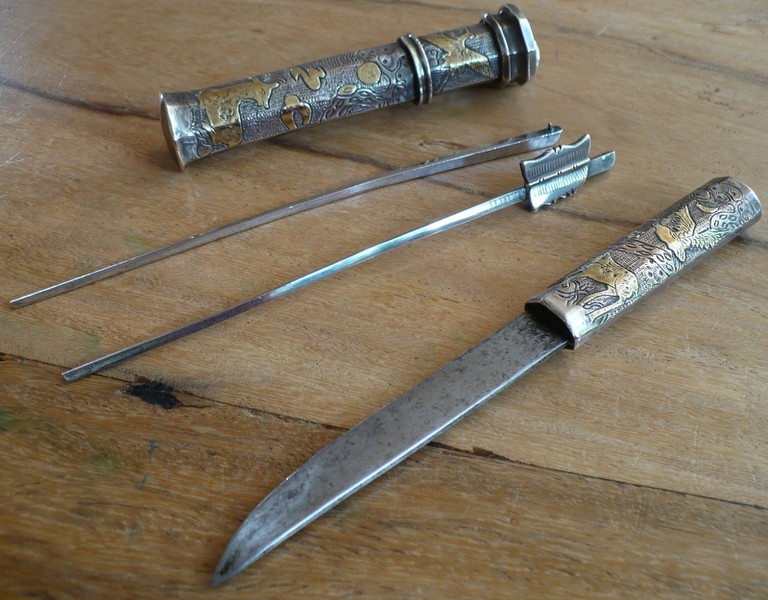
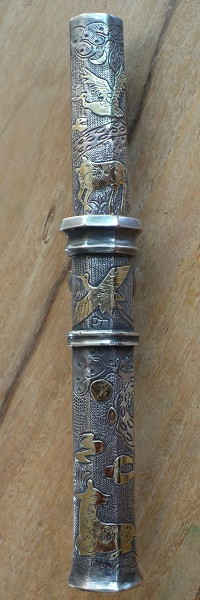
Eunjangdo & Mojaebijangdo in an octagonal case. The front is a shangri-la kind of theme, the pine trees and the gold cranes symbolize longevity, and the gold deer symbolize wealth and prosperity. The area below the crane is stylized rockwork. The curly objects with gold wash are clouds. In the past, people believed that when they accumulated enough good deeds in this world, they rode clouds to the sky and became a human Buddha in the next world. Shapes of cloud can also be found on the murals in ancient tombs.

On the blade handle we see a gold-washed Moon (the moon's roundness is a symbol of family unity and harmony) and snake’s head. The snake is, according to Joseph Campbell, the ultimate symbol of lunar consciousness, because the snake sheds its skin just as the Moon does.

The area below the Crane is stylized rockwork. The snake is also spherical, symbolizing the infinite. And, ultimately, the snake continues to live in the face of adversity, just as the honorable woman could expect to live on after the self-inflicted honourable death of her physical self, according to the teachings of the time. Kum-Boo (also spelled keum-boo or kum-bu) is a Korean decorative appliqué technique in which pure gold foil is fused onto the surface of finished silver objects.
The origin and historical development of the kum-boo technique are little known, but it is clear that Koreans have been using brass, silver, and gold ware and utensils for their daily eating and ceremonial purposes for thousands of years.
Koreans and other East Asian peoples traditionally believed that the ingestion of pure gold would improve health and well-being. For this reason, many Korean silver utensils are decorated with 24-karat gold overlays in the form of letters and patterns that convey wishes for good health, wealth and longevity.

The pattern on the back is a “Pullocho” plant, which symbolizes wishes come true. The chopsticks were used to detect poisoned food. The attachment to the chopstick is a cicada, symbolising immortality

Attached at the point where the sheath and the blade handle join, we see a chrysanthemum flower, the Korean symbol of a productive, fruitful life.
https://www.korea.net/NewsFocus/Culture ... eId=187661
Patterns like the ten symbols of longevity, bats, dragons, butterflies, the Four Gracious Plants and pine trees were engraved on jangdo sheaths to pray for blessings and symbolize fidelity.
We do not often, at the forum, see silver from Korea; have there ever been any laws about silver & gold standards in Korea. Not much is known about Korean’ gold & silver smiths prior 20th century perhaps due to the fact that at a certain time in Korea's history, the art of black-silversmithing was frown upon? I do hope we get some reactions and more examples of Sino-Korean silver!
